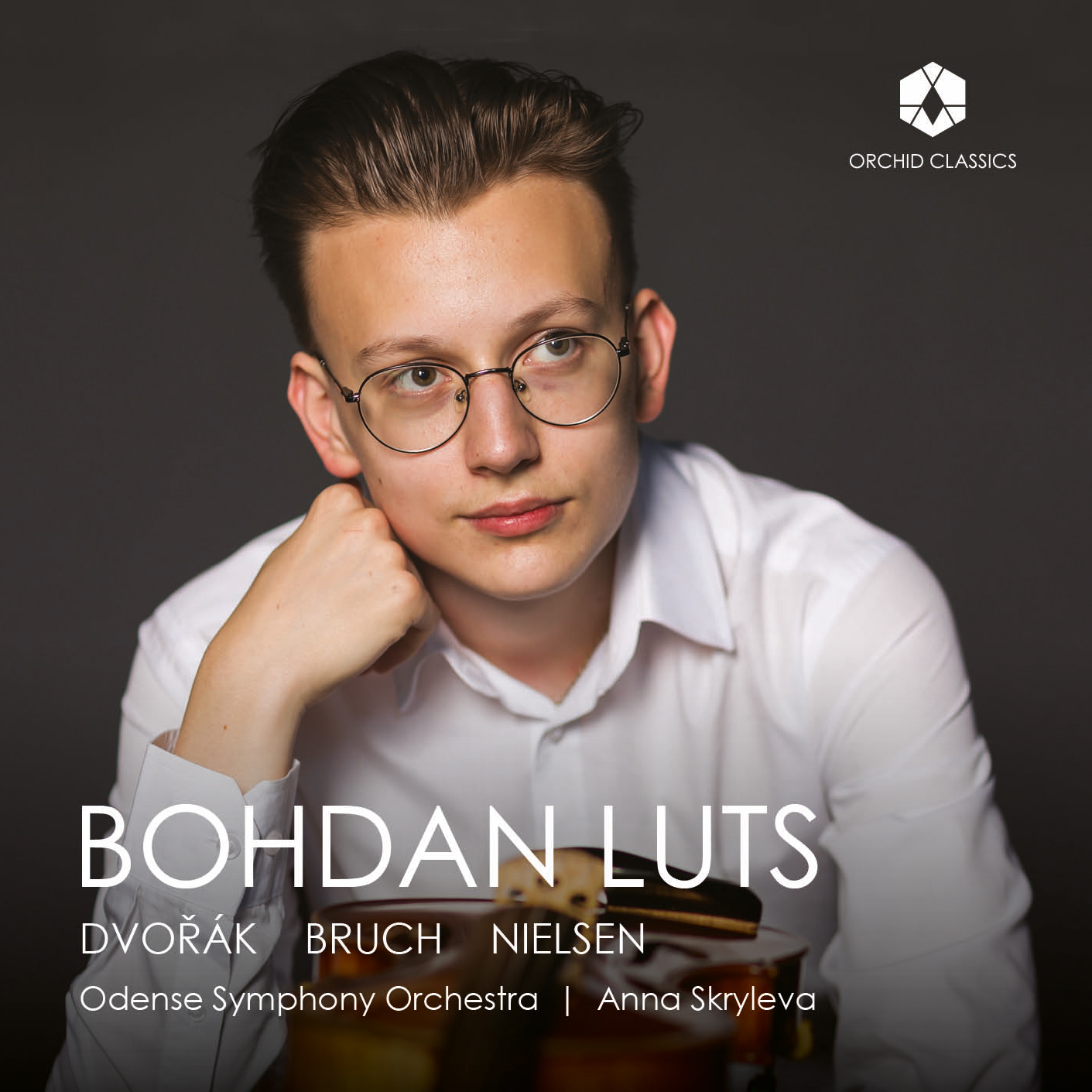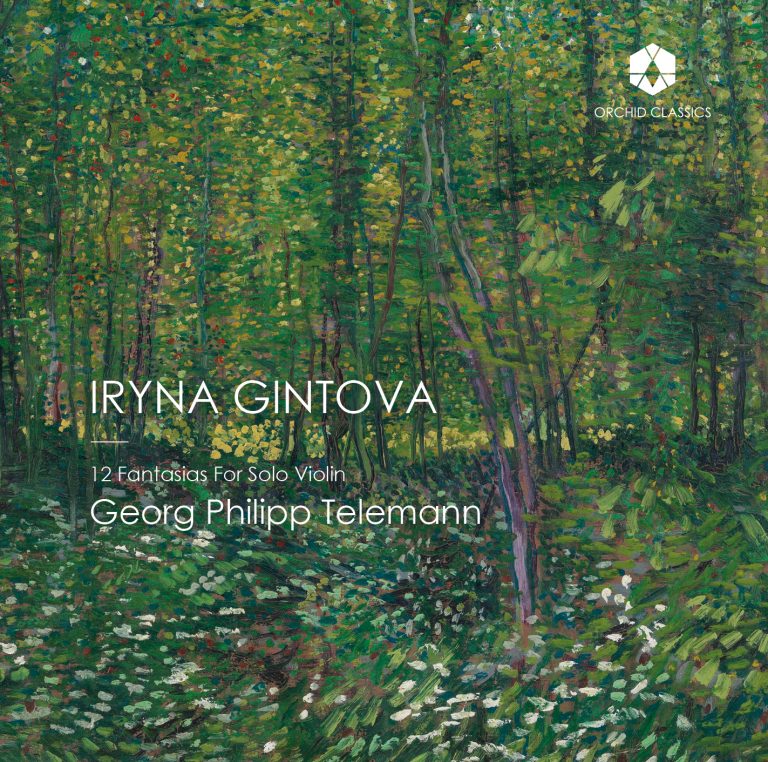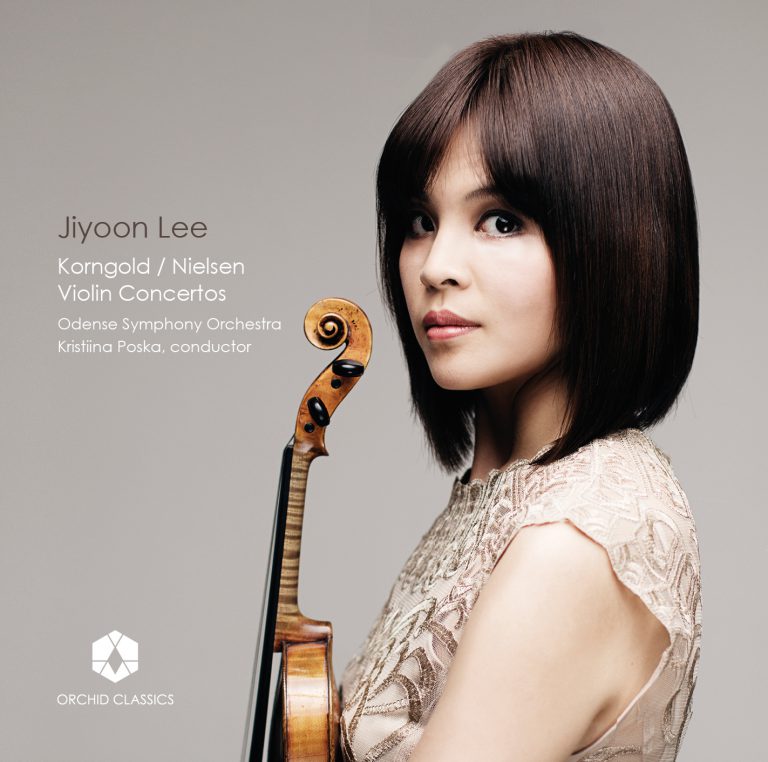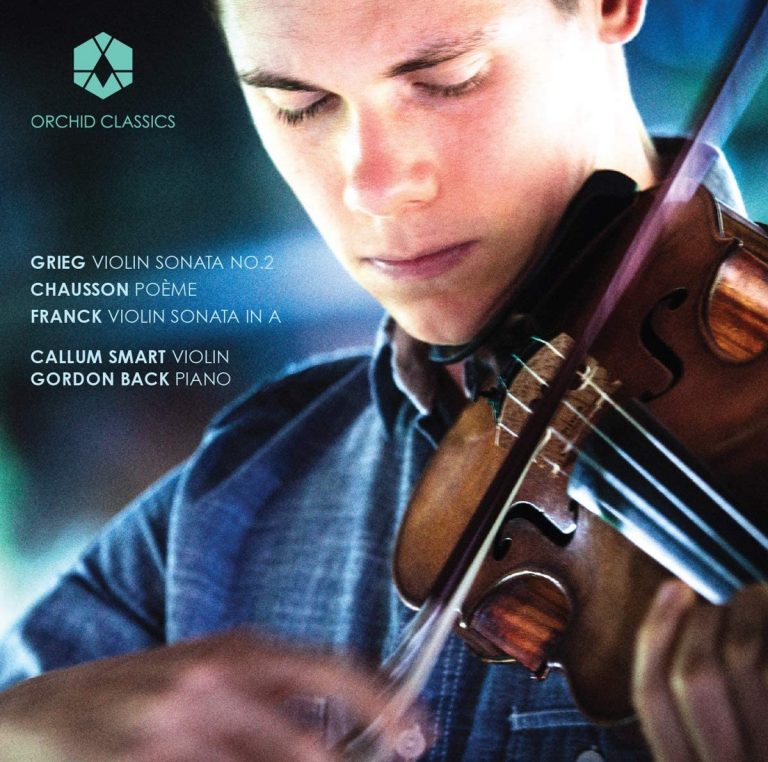Artist Led, Creatively Driven

BOHDAN LUTS: VIOLIN
Odense Symphony Orchestra
Anna Skryleva, conductor
Release Date: June 21st
ORC100301
Antonin Dvořák (1841-1904)
Concerto for Violin and Orchestra in A minor, Op.53, B.108
1. I Allegro ma non troppo
2. II Adagio ma non troppo
3. III Finale. Allegro giocoso, ma non troppo
Carl Nielsen (1865-1931)
2 Fantasy pieces, Op.2, FS 8
4. I Andante con duolo
Max Bruch (1838-1920)
Scottish Fantasy, Op.46
5. I Grave – Adagio cantabile
6. II Scherzo: Allegro
7. III Andante sostenuto
8. IV Finale: Allegro guerriero
Bohdan Luts, violin
Odense Symphony Orchestra
Anna Skryleva, conductor
Having completed musical posts in Mannheim, Koblenz, Sondershausen and Berlin, the year 1880 constituted a new chapter for German composer Max Bruch as he began his tenure as Liverpool Philharmonic Society Principal Conductor. The year also marked the completion of the Scottish Fantasy, Op.46, which emerged from a particularly productive period of composition for the violin in Bruch’s career. The late 1870s saw the composition of Bruch’s Violin Concerto No.2 in D minor, Op.44, as well as a highly successful performance of the enduringly popular Violin Concerto No.1 in G Minor, Op.26, conducted by Bruch, with renowned Spanish virtuoso Pablo de Sarasate as soloist.
The Scottish Fantasy stands atop several works from the late 18th century which draw on Scots influences, indicative of a contemporaneous fascination with national styles, and that of Scotland more specifically. The incorporation of prominent harp textures is one tell-tale feature indicating Scottish associations, as detailed by the full title of the work: Fantasie für die Violine mit Orchester und Harfe unter freier Benutzung schottischer Volksmelodien (“Fantasy for the Violin with Orchestra and Harp, freely using Scottish folk melodies”). This emanant subordinate texture underpins the virtuosic and rangy violin writing, akin to the atypical sophistication of melody lines and playing ability of traditional Scottish fiddlers.
The first tutti orchestral passage is a majestic Adagio cantabile which bridges between the hazy, foggy opening and introduction of the first melody, scored in a quasi-chamber style. The violin presents the first Scottish folk theme, “Through the Wood Laddie”, flourishing from an introspective opening to the outwardly expressive body of the movement. The violin takes on furthered virtuosity as the mood shifts to a lively and dance-like scherzo, featuring the folk tune “The Dusty Miller”. Characterised by its energetic and rhythmic vitality, the second movement embodies the character of the Classical period symphony in melody and phrase structure, as well as its texture and the interplay of the parts.
There is a seamless transition to A-flat major and attacca into the third violin melody, a lyrical interlude with the main theme based on “I’m a-Doun for Lack o’ Johnnie”. Perhaps the best example of the interplay between key areas a third apart, the movement is rhythmically expansive, its fluidity aided by the polyrhythmic writing between soloist and orchestra. The final movement, marked by its heroic and spirited character, incorporates the Scottish melody “Hey, Tuttie Tatie”. This movement brings the work to a triumphant conclusion but retains its song-like character. The thick chordal writing is texturally robust, matched by the prevalence of triple stops in the solo line. Making use of a refrain-based structure, the movement re-establishes E-flat major after period of downwards third tonal shifts to provide a cyclical tonal resolution to the Fantasy.
Pablo de Sarasate had been the soloist for the 1877 performance of the Op.21 concerto and the dedicatee of the Op.44 concerto. Earmarked by Bruch for the inaugural performance of the Fantasy, Sarasate was only eventually engaged for the 1883 delivery in a memorial concert for Richard Wagner. The premiere was in fact given by Joseph Joachim, the preeminent violinist of the time, known for his close working relationship with Johannes Brahms. Notwithstanding the prowess of Joachim, the collaboration was far from a good fit, leaving Bruch immensely dissatisfied with the interpretation: an “annihilation” in his own words. Sarasate’s later renditions, on the other hand, were recognised as some of the most widely respected of the period, and pivotal in establishing the Fantasy’s enduring place in the canon of Romantic-era violin repertoire.
The interconnectedness of musical projects in the late eighteenth century is evidenced by several elements of Antonín Dvořák’s Violin Concerto in A Minor, Op.53 (1879), in common with the Scottish Fantasy. The first of these is the obvious folk element in the concerto, where the modal aspects and dance-like elements lend the music a character prevalent in Dvořák’s folk-oriented output, not least his seminal Op.46 and Op.72 Slavonic Dances. Noteworthy, however, is Dvořák’s simultaneous regard for the tenets of the Classical symphony. The finale, Allegro giocoso, ma non troppo, exhibits its dance-like qualities alongside intermittent unisons, repetitions and imitations, pre-dominant diminished colour, Alberti figures and shadowing of melody lines in the middle winds in a manner which harks back to the bucolic expansiveness of Beethoven’s Pastoral Symphony. Elsewhere, the florid development of the soloist’s melody in the first movement is characteristic of Dvořák’s ability to reformulate melodic units in variation form, another hallmark of his oeuvre. There is something elegiac to be read in the character of the second movement, Adagio ma non troppo; Dvořák underwent a period of personal mourning during the composition of the concerto following the death of his sister-in-law, Josefina Kaunitzová.
Other factors in common with the genesis of the Scottish Fantasy include the link to Nikolaus Simrock, founder of the leading publishing house of the time, a close associate of Dvořák. The nature of the working relationship between the Dvořák and violinist Joseph Joachim is documented in the Czech composers’ correspondence with Simrock. Clearly favoured by Dvořák for the premiere of the work, Joachim did not in fact perform the 1883 premiere in Prague, nor the subsequent Vienna and London premieres. František Ondříček, a young Czech violinist, was the soloist on these occasions, and on many others subsequently. Despite widespread assumption that Joachim’s absence was due to a lack of interest in the work, he cannot have been completely disengaged, given his feedback for refinements to numerous aspects being documented by Dvořák in writings to Simrock.
Carl Nielsen has received enduring acclaim as Denmark’s foremost composer, yet it is his ability as a violinist that is noteworthy in relation to his Romance, Andante con duolo, from the Op.2 Fantasy Pieces. Nielsen was, in fact, a violinist in the Royal Danish Orchestra in Copenhagen from 1889 to 1905. Nielsen’s training and early career were focused on the violin, and he initially gained recognition as a violinist before turning his attention more fully to composition. Similarly remarkable is the musical maturity of Nielsen’s early career, the young Dane having assumed a position as an army musician in Odense in as a fourteen-year-old, later being admitted for free to the Copenhagen Conservatoire under Niels W. Gade in 1883.
Within the pantheon of Romantic works for the violin, unlike the Scottish Fantasy and the Violin Concerto in A Minor, the Nielsen character piece is relatively anonymous. This is not least because of its initial conception and publication for the oboe, with piano accompaniment. Its first performance was given at the Royal Orchestra Soirée in Copenhagen 1891 by oboist Olivo Krause accompanied by pianist Victor Bendix. It is documented that, subsequently, the accomplished Nielsen performed the fantasy pieces with Bendix, for whom he had great affection, in an informal setting. Whilst drawing a straight line to its eventual translation and publication for violin with orchestra by violinist Hans Sitt may be tenuous, it is possible that this was the original inspiration for the arrangement of the Op.2 Romance for different forces. The piece continued to receive outings over the following decades in version scored for violin and orchestra, violin and piano, and violin with organ accompaniment, with Nielsen reprising his role as violinist on at least one of these occasions.
Bohdan Luts
Violin
Bohdan Luts was born in Lviv in 2004. He studied at the Kyiv State Music Lyceum in the class of Olga Korinets and at the Lviv State Music Lyceum in the class of Maria Futorska. He is currently a student at the International Menuhin Music Academy in Switzerland in the class of Oleg Kaskiv, Guillaume Chilemme and Renaud Capuçon, and regularly participates in master classes of famous musicians and teachers such as Gabor Takacz-Nagy, Liviu Prunaru, Nikolaj Szeps-Znaider, Pablo de Naverán, Ivan Vukčević, Jean-Jacques Kantorow and others.
Bohdan has won numerous prizes at international competitions. He was awarded the Grand Prix and First Prize at the International Competition “Lviv Virtuoso” and at the International Competition of Bohdan Varhal “Talents for Europe” in Slovakia and won First prizes and four special awards at both the III and V International Competition of Young Violinists “I will be a virtuoso” (Poland). In 2015 he won the Second prize at the XVII Kocian International Violin Competition in Czech Republic and in 2017 the Third prize at the X Arthur Grumiaux International Violin Competition in Belgium. One year later he won the Second prize at the International Competition “Il piccolo violino magico” in Italy. In 2021, he won the Third prize at the Lipizer International Violin Competition (Italy, 2021). And in 2022, at the age of 17, he won the First Prize at the prestigious Carl Nielsen International Competition in Denmark and the First Prize, as well as the Audience Award, at the 2nd Alberto Lysy International Violin Competition in Gstaad. As well, in 2023 at the age of 18, Bohdan has won Long Thibaud International Violin Competition as well as the Audience, Press Jury and French Republican Guard Orchestra prizes.
He has played concerts in countries such as Switzerland, Denmark, France, Slovakia, Poland, Italy and Ukraine and participated in international festivals such as the Gstaad Menuhin Festival or the Bellerive Music Festival (France). He performed as a soloist with the Košice Symphony Orchestra (Slovakia), the Copenhagen Philarmonic, Odense Symphony Orchestra , the Lviv National Philharmonic Symphony Orchestra, the Orchestra Sinfonica di Friuli Venezia Giulia, the Lviv Virtuosos Chamber Orchestra, the Trembita Chamber Orchestra, the INSO-Lviv Symphony Orchestra, the Kyiv Chamber National Soloists’ Ensemble and others. He played with such conductors as Michel Plasson, Anna-Maria Helsing, Taras Krysa, Yaroslav Shemet, Jurek Dybal, Jean Jacques Kantorow and others.
Currently, Bohdan has signed a 2-year contract with the “Nordic Artists” management. Forthcoming projects include a solo recording with the Odense Symphony Orchestra for Orchid Classics and solo appearances with top Nordic orchestras.
Anna Skryleva
Conductor
Conductor Anna Skryleva, music director of Theater Magdeburg since the 2019/20 season, is one of the most fascinating artistic personalities of a new generation. Her award-winning work to enlarge the classical repertoire has caused international attention. Her discovery of the German-Jewish composer Eugen Engel and his opera “Grete Minde” ensured international success in February 2022.
At Magdeburg Opera her conducting of the “Kat’a Kabanova” and “Turandot” productions was celebrated by international reviews and local audiences alike. Recent engagements have brought Anna Skryleva to orchestras and opera companies across Europe and North America, such as the Royal Opera Stockholm, the Hamburg Staatsoper and the operas of Wiesbaden and Darmstadt. 2017 saw her début at Dallas Opera with programmes of music by Giuseppe Verdi. An internationally renowned conductor also in symphonic repertoire, Anna Skryleva has lead concerts with esteemed orchestras such as the Copenhagen Philharmonic, Frankfurt Radio Symphony, Odense Symphony Orchestra, Staatsphilharmonie Rheinland Pfalz and Aarhus Symphony, among others. In the season 2021/2022 she was scheduled by renowned orchestras such as Deutsches Symphony Orchestra Berlin, Beethoven Orchester Bonn and Fort Worth Symphony Orchestra.
Anna Skryleva is a rising very promising composer. Her version for the reduced orchestra of the Mozart’s “La clemenza di Tito”, successful performed at Theater Magdeburg in September 2020 under direction by Dietrich Hilsdorf, is now on sales by the renowned Mozart’s publisher Bärenreiter. Skryleva’s compositions “Impromptus in C” were recognized by several Festivals: “The Solen Music Festival” and “Klang Art Vision”.
Anna Skryleva was deputy music director from 2012 to 2015 at Schleswig-Holsteinisches Landestheater and, subsequently, at Darmstadt Opera. Performances ranged from symphonic programmes of Messiaen, Françaix, Berlioz, Britten and Stravinsky to a wide range of operas, including Verdi’s “Otello” and “La Traviata”, Wagner’s “Tristan und Isolde”, Puccini’s “La Bohéme” and “Il Trittico”, Humerdinck’s “Hansel und Gretel”, Weber’s “Der Freischütz”, Strauss “Salome”, Kurt Weill’s “Rise and Dall of the City Mahagonny” and “Cinderella” by Prokofiev. In 2015 she had her successful début at Staatstheater Wiesbaden with “Madama Butterfly”. From 2007 to 2012 Anna Skryleva was assistant conductor and vocal coach under artistic director Simone Young at Hamburg State Opera. In this capacity she collaborated in a groundbreaking new production of the “Ring des Nibelungen” cycle and was an assisting conductor by major revivals of “Parsifal”, “The Flying Dutchman”, “Salome”. Elektra” and “Chovanshtshina”. She conducted opera productions at the Hamburg State Opera’s Young Singers Project, leading both the Hamburg Symphony and Hamburg Philharmonic Orchestras.
In 2019 Anna Skryleva was awarded the Orchestra Innovation Prize by the German National Orchestras Foundation for her work with the Magdeburg Philharmonic Orchestra. Today a resident of the vibrant musical city of Berlin, pianist, composer and conductor Anna Skryleva had been raised in Moscow. At age five she received her first piano lessons, at eight she completed her first own composition. Anna was accepted to the composers’ class at Moscow’s Tchaikovsky Conservatory when was ten. That same university later trained her as a pianist and chamber musician. Having completed her piano studies at Berlin’s Universität der Künste Berlin with Klaus Hellwig, she then joined the conducting class of Lutz Herbig in Düsseldorf. Anna Skryleva has been a fellow of the five-year promotion programme of the Institute for Women Conductors at Dallas Opera between 2015 and 2020.
Odense Symphony Orchestra
The Odense Symphony Orchestra is one of Denmark’s five regional orchestras. The orchestra was founded in 1946, but its roots go as far back as around 1800. From being a theatre orchestra that also played symphonic music, the orchestra today appears as a modern symphony orchestra with a high level of activity and in a constant state of development. The orchestra’s repertoire has a wide range and covers everything from film concerts, chamber music, family concerts to the great symphonic works and opera, such as Richard Wagner’s Der Ring des Nibelungen.
Odense Symphony Orchestra had 22 musicians at its founding, but has grown to 73 permanent musicians over the years, from Denmark and all over the world. The orchestra performs around 100 concerts a year. The majority of the concerts take place in the Carl Nielsen-hall in Odense’s Concert house, near H.C. Andersen’s Birthplace – but the orchestra tours throughout Denmark and the rest of the world.
Odense Symphony Orchestra is the owner and host of Carl Nielsen International Competition, and the orchestra and its musicians play an important role in the competition as jury members, repertoire consultants and contact persons to many international artists.
The first of the Carl Nielsen International Competitions was held in Odense in 1980. After nearly four decades, the violin, clarinet and flute competitions have established themselves as some of the most demanding and rewarding in the world, by highlighting Carl Nielsen’s musical masterpieces, and offering each winner the chance to launch a significant international career.
For more information on Carl Nielsen International Competition please visit
www.carlnielseninternationalcompetition.com.









